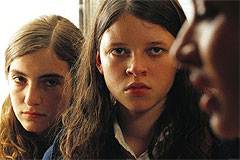
| HOME |
| NERVE |
| REVIEWS |
| ARCHIVE |
| EVENTS |
| LINKS |
| ABOUT US |
| CONTRIBUTORS |
| BACK ISSUES |
| CONTACT US |
 La
Nina Santa / The Holy Girl (15)
La
Nina Santa / The Holy Girl (15)
Directed by Lucrecia Martel, Written by Juan Pablo Domenech and Lucrecia
Martel,
Showing at FACT from March 25th - 31st
Reviewed by Tim Kopp
La Nina Santa is an intriguing mood piece about sexual awakening, Catholic notions of guilt and sin and the unsettled emotional state of its characters. In its best moments the film has a haunting and dreamlike quality but its ambiguities are likely to frustrate audiences expecting a clear-cut narrative. *** out of five
The Argentine town of La Ciènaga, the present. Amalia, a teenage girl, lives with her mother Helena and her uncle in the hotel Termas, where doctors and surgeons are gathering for an international medical conference. Together with her friend, Josefina, Amalia engages in discussions of “pre-marital relationships” while attending a Bible study class where a devoutly Catholic teacher tells her students to follow God’s call. Meanwhile, Helena learns that her ex-husband’s new wife is expecting twins. Unsettled by the news and increasingly exasperated, Helena is drawn to Doctor Jano who is staying at the hotel as a conference delegate. When Jano pushes himself up against Amalia during a music performance, Amalia comes to believe that God is calling on her to save Jano, and seeks his attention.
The opening scene of La Nina Santa, in which teenage friends Amalia and Josefina discuss pre-marital sex during Bible study sessions, suggests a coming-of-age story about teenage sexuality and its religious connections to sin, guilt, sexual desire and repression in a predominantly Catholic society. The film delves into this further when Doctor Jano, a speaker at the international conference, makes his pass at Amalia.
Overcoming her initial shock and believing to be on a mission to save him from committing further sins, she is drawn to him. Martel credibly conveys the agitation and the desire that Amalia experiences in this moment, and handles the subsequent scenes when the girl’s early discomfort seems to give way to increasingly greater attraction towards Jano, with equal dexterity and conviction. Amalia begins to stalk him, glancing at him across the hotel’s swimming pool from the distance and it is in these moments that La Nina Santa hints at the possibility of a story of a forbidden love between the virgin girl and the object of her fascination and attraction.
As the film progresses, it develops another plot involving Amalia’s mother Helena that deals with Helena’s troubled emotional state after the break-up of her marriage. Her feelings of restlessness and apparent longing for greater stability are compounded when she learns that her ex-husband’s wife expects twins and repeatedly attempts to contact Helena. Helena’s refusal to talk implies a desire on her part to break free from the past and this need to move on is reflected in her at first passing then increasingly greater interest for Jano. The film depicts this in a deliberately ambiguous, oblique manner that requires the viewer to infer the characters’ feelings and motivations and possible plot developments, and creates a dreamlike atmosphere supported by Andres Gerszenzon’s score while Felix Monti’s cinematography echoes the film’s elusiveness in occasionally indistinct images and peculiar angles. Martel’s style is creditably consistent also in the manner with which she refuses to pass judgement on her characters, and defies conventions by ending the film with an incomplete resolution. The different themes and storylines are impressively tied together when one of the girls commits an act of betrayal on her friend that in turn has repercussions on others.
Martel’s enigmatic style is undeniably effective and appropriate for the uncertainty, indecisiveness and restlessness that defines the characters and their actions from start to end: this, in general, appears to be the main concern of the film. And yet, as potent and intriguing as it is (the picture’s closing scene is particularly haunting), there is something oddly unsatisfying about La Nina Santa, as if it was a bit too insistent on merely suggesting rather than fully developing at least some of the scenarios that it builds up to. That said, Martel’s film is a fascinating mood piece that has the potential to grow on, and reward open-minded audiences with repeated viewings.